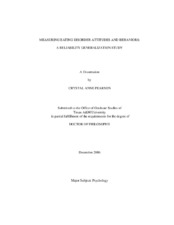| dc.description.abstract | I used reliability generalization procedures to determine the mean score reliability
of the Eating Disorder Inventory (EDI), the Eating Attitudes Test (EAT), and the
Bulimia Test (BULIT). Reliability generalization is a type of meta-analysis used to
examine the mean score reliability of a measure across studies and to explore study
factors that influence mean score reliability. Score reliability estimates were included in
28.67% of 293 studies using the EDI, 36.28% of 215 studies using the EAT, and 41.46%
of 41 studies utilizing the BULIT. For the EDI, mean Cronbach’s alphas for the
subscales ranged from .52 to .89 and the mean estimate for the total score was .91. For
the EAT-40 and EAT-26, mean estimates of internal consistency were .81 and .86
respectively. Mean estimates of internal consistency for the EAT-26 subscales ranged
from .56 to .80. The mean estimate of internal consistency for the BULIT-R was .93.
Overall, the mean reliability of scores on all three measures and their subscales/factors
was acceptable except for the Asceticism subscale of the EDI and the Oral Control factor
on the EAT-26, which had mean internal consistency estimates of .52 and .56
respectively. For the EDI, the majority of the subscales that measure specific eating disorder attitudes and behaviors, such as Bulimia and Perfectionism displayed higher
score reliability in clinical eating disorder samples than in nonclinical samples. This
difference was not found in the Drive for Thinness and Body Dissatisfaction subscales,
perhaps because these attitudes are common in both eating disorder and nonclinical
samples. Score reliability information for the EAT and BULIT was primarily reported for
nonclinical samples; therefore, it is difficult to characterize the effect of type of sample
on these measures. There was a tendency for mean score reliability for all the measures
to be higher in the adult samples than in adolescent samples and in the female samples
compared to the male samples. This study highlights the importance of assessing and
reporting internal consistency every time a measure is used because reliability is affected
by characteristics of the participants being examined. | en |


